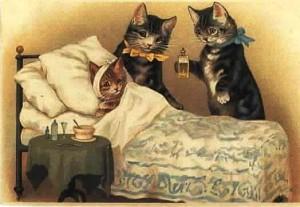Heritage Animal Hospital: 10 Signs of Illness In Cats
Cats are masters of disguise. It can be very difficult to identify if your cat doesn’t feel well. Here are 10 signs of illness to watch for:
Inappropriate elimination
Urinating in places other than their litter box or using the litter box more frequently. Inappropriate elimination can be associated with a variety of conditions including lower urinary tract disease, urinary tract infection, diabetes, and even arthritis.
Changes in Interaction
Cats are typically very social animals any changes in interaction with humans or other pets can signal possible disease, fear, or pain.
Changes in Activity
A decrease in activity could be a sign of arthritis or other systemic illness. An increase in activity could be suggestive of hyperthyrioidism.
Changes in Sleeping Habits
If your cat is sleeping more than normal it could be a sign of underlying disease.
Changes in Food and Water Consumption
Decreased food intake can be a sign of many disorders. Increased food consumption could be a sign of diabetes, hyperthyroidism or several other conditions.
Unexplained Weight Loss or Gain
Sudden weight loss can be a sign of hyperthyroidism, diabetes, or many other diseases. Obesity can cause increased risk of diabetes, joint problems, and other metabolic diseases.
Changes in grooming
Patchy hair loss, greasy, or matted appearance can signal underlying disease. Cats who have difficulty grooming often suffer from anxiety, obesity, or other illnesses. An increase in grooming can indicate a skin problem.
Signs of Stress
Stressed cats may show signs of depression, hide more, or spend more time awake and scanning the environment. These signs can indicate an underlying illness. It is important to rule out any type of physical ailment before addressing possible behavioral issues.
Changes in Vocalization
Increased vocalization could indicate hyperthyroidism, high blood pressure, pain, or anxiety.
Bad Breath
Bad breath can be an early indicator of oral disease.
- Log in to post comments


























